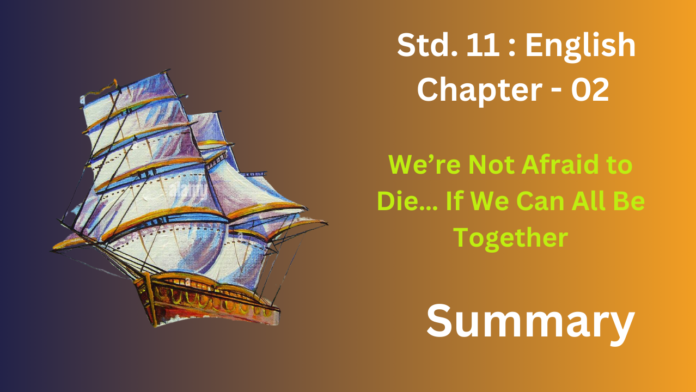“We’re Not Afraid to Die… If We Can All Be Together” is a harrowing tale of a family’s extraordinary resilience and courage in the face of a life-threatening ordeal at sea. The narrator, along with his wife Mary, their children Jonathan and Suzanne, and crew members Herb Seigler and Larry Vigil, embark on a round-the-world voyage inspired by Captain James Cook. Their journey takes a perilous turn when they encounter a monstrous wave in the Southern Indian Ocean.
The story highlights the family’s unwavering determination to survive. Despite the boat’s severe damage and the constant threat of sinking, they maintain a remarkable sense of calm and unity. The children, particularly Suzanne, display incredible bravery, even as they suffer injuries. The crew members, Herb and Larry, work tirelessly to repair the boat and keep it afloat. The narrator’s leadership and navigation skills are crucial in their struggle against the elements.
The narrative emphasizes the power of human spirit, the importance of family bonds, and the ability to find hope in the face of overwhelming adversity. Ultimately, through their collective effort and unwavering belief in each other, they manage to survive the ordeal and reach Ile Amsterdam, a small volcanic island, proving that even in the most desperate situations, courage and unity can prevail.
Exercise
1.List the steps taken by the captain.
(i) to protect the ship when rough weather began
(ii) to check the flooding of the water in the ship
Ans:
(i) To protect the ship when the rough weather began, the captain took several crucial steps. First, he ordered the crew to drop the storm jib and lash the heavy mooring rope in a loop across the stern. This maneuver was designed to slow the ship’s speed and reduce the impact of the massive waves. Then, he instructed everyone to prepare for survival by donning their oilskins and life jackets.
(ii) To check the flooding of the water in the ship, the captain immediately assigned tasks to the crew. Larry and Herb were put in charge of continuously pumping out the water. The captain himself, along with his family, worked tirelessly to cover the gaping holes in the ship’s hull with canvas and to divert the water flow. When the hand pumps failed, he found an electric pump and connected it to drain the water. He also organized the crew to bail out water using buckets and any available containers. His continuous monitoring and directing of these efforts were critical in managing the relentless influx of water, preventing the ship from sinking.
2.Describe the mental condition of the voyagers on 4 and 5 January.
Ans:
On January 4th and 5th, the mental condition of the voyagers was one of extreme exhaustion mingled with a fragile, yet persistent, hope. They were physically and emotionally drained from days of battling the relentless storm and the constant threat of sinking. The continuous struggle against the elements, the lack of sleep, and the constant bailing of water had taken a severe toll.
However, amidst the exhaustion, a sense of determination prevailed. They clung to the hope of survival, driven by the strong family bonds and the shared desire to overcome adversity. The captain, despite his own physical and mental strain, maintained a sense of leadership and focused on the task at hand. The children, especially Suzanne, showed remarkable resilience, offering comfort and support to their parents.
The voyagers’ mental state was a complex mix of despair and resolve. They were acutely aware of the precariousness of their situation, yet they refused to surrender. They drew strength from their unity, their faith, and their unwavering belief in their ability to survive, even as they faced the daunting prospect of death.
3.Describe the shifts in the narration of the events as indicated in the three sections of the text. Give a subtitle to each section.
Ans:
Section 1: The Pleasant Prelude (Subtitle: “Setting Sail: A Dream Turns Real”)
- This section establishes the initial optimism and excitement of the voyage. The narration is calm and descriptive, detailing the preparation, the crew, and the early stages of the journey. It conveys a sense of adventure and the fulfillment of a long-held dream. The tone is positive, with a focus on the planning and the anticipation of a successful round-the-world trip. The narration is largely factual and observational, setting the stage for the dramatic events to follow.
Section 2: The Storm’s Fury (Subtitle: “Into the Abyss: A Battle for Survival”)
- This section plunges the reader into the heart of the crisis. The narration becomes intense, dramatic, and filled with urgency. It details the terrifying encounter with the monstrous wave, the ship’s severe damage, and the constant struggle to stay afloat. The focus shifts to the immediate actions taken to save the vessel and the crew. The language is vivid and visceral, conveying the sheer terror and physical hardship of the situation. The emotional tone shifts from hopeful to desperate, highlighting the voyagers’ fear and determination.
Section 3: The Triumph of Hope (Subtitle: “Land Ahoy: Resilience and Reunion”)
- This section documents the gradual recovery and the eventual arrival at Ile Amsterdam. The narration becomes more reflective and emotional, focusing on the voyagers’ resilience and the strength of their family bonds. It emphasizes the relief and joy of finding land, as well as the lasting impact of their ordeal. The tone shifts from desperate survival to hopeful relief. The narration also highlights the children’s bravery, and the importance of everyone working together. The focus is on the emotional and psychological aspects of survival, as well as the physical journey.
Talking about the text
Discuss the following questions with your partner.
1. What difference did you notice between the reaction of the adults and the children when faced with danger?
Ans: When faced with extreme danger, the adults and children in “We’re Not Afraid to Die… If We Can All Be Together” exhibited distinct reactions. The adults, particularly the captain and his wife Mary, displayed a focused and pragmatic approach, prioritizing survival through immediate action. They worked tirelessly to repair the ship, manage the flooding, and navigate through the treacherous conditions. Their reactions were driven by a sense of responsibility and a need to maintain control in a chaotic situation. In contrast, the children, Jonathan and Suzanne, demonstrated remarkable emotional resilience and a profound sense of calm. Despite their injuries and the perilous circumstances, they offered unwavering support and comfort to their parents. Suzanne, in particular, tried to minimize her parents’ worries by assuring them they were alright, even when she was in pain. While the adults were consumed by the practicalities of survival, the children provided crucial emotional stability, highlighting the strength of their familial bond and their ability to remain composed in the face of fear.
2. How does the story suggest that optimism helps to endure “the direst stress”?
Ans:
“We’re Not Afraid to Die… If We Can All Be Together” powerfully demonstrates how optimism serves as a crucial tool for enduring “the direst stress.” Throughout the narrative, even in the face of overwhelming adversity, the characters maintain a sense of hope that fuels their survival. The captain’s consistent efforts to repair the ship and navigate towards safety, despite the daunting odds, reflect a belief in their ability to overcome the crisis. Mary’s unwavering support and practical actions, even when faced with the threat of death, show a determined optimism. The children, particularly Suzanne, exhibit remarkable resilience, assuring their parents they are alright and minimizing their own pain, thus helping to maintain a positive mental state for the entire family. This collective optimism fostered a sense of unity and determination, enabling them to persevere through exhaustion, injury, and fear. The narrative emphasizes that maintaining a positive outlook, even in the most desperate situations, provides the mental strength and motivation necessary to endure and ultimately survive extreme challenges.
3. What lessons do we learn from such hazardous experiences when we are face-to-face with death?
Ans:
Hazardous experiences that bring us face-to-face with death impart profound lessons about the fragility and preciousness of life. They strip away trivial concerns, forcing us to prioritize what truly matters: human connection, love, and the simple act of survival. Such encounters reveal the immense strength of the human spirit, our capacity for resilience, and the power of unity in the face of overwhelming odds. We learn the importance of courage, not as the absence of fear, but as the ability to act despite it. Moreover, these experiences often underscore the value of hope and optimism, demonstrating how a positive mindset can be a vital tool in enduring extreme stress. We understand that even in the direst circumstances, our ability to connect, support, and rely on one another can become the cornerstone of survival. Ultimately, these experiences teach us to appreciate the present moment and to live with a greater sense of purpose and gratitude.
4. Why do you think people undertake such adventurous expeditions in spite of the risks involved?
Ans:
People undertake adventurous expeditions despite the inherent risks for a multitude of compelling reasons. Firstly, there’s the undeniable allure of the unknown, the desire to push boundaries and explore the limits of human capability. The thrill of facing challenges and overcoming obstacles provides a profound sense of accomplishment and self-discovery. Secondly, many expeditions are driven by a deep-seated curiosity about the world, a yearning to witness its natural wonders and experience cultures beyond the familiar. For some, it’s a quest for knowledge, a scientific pursuit to understand the planet’s ecosystems or geological formations. Additionally, there’s the intrinsic human desire for adventure, a need to break free from routine and experience the raw, untamed beauty of nature. The sense of freedom and independence that comes with navigating uncharted territories is a powerful motivator. Finally, for some, it’s a personal challenge, a way to test their physical and mental endurance, and to prove their resilience in the face of adversity. The risks, while acknowledged, are often outweighed by the potential for extraordinary experiences and the profound sense of fulfillment that comes with achieving the seemingly impossible.
Thinking about language
1. We have come across words like ‘gale’ and ‘storm’ in the account. Here are two more words for ‘storm’: typhoon, cyclone. How many words does your language have for ‘storm’?
Ans:
- Toofan (तूफान): This is a very common word, generally referring to a strong storm, similar to a gale or typhoon.
- Aandhi (आंधी): This specifically refers to a dust storm or a strong windstorm.
- Chakravat (चक्रवात): This is the Hindi equivalent of “cyclone.”
- Varsha-toofan (वर्षा-तूफान): This refers to a rainstorm.
- Jhakkad (झक्कड़): This refers to a strong, blustery wind.
- Badal-phatna (बादल फटना): This refers to a cloud burst, which is a very heavy and sudden rain storm.
2. Here are the terms for different kinds of vessels: yacht, boat, canoe, ship, steamer, schooner. Think of similar terms in your language.
Ans:
- Nauka (नौका): This is a general term for “boat” or “vessel,” often referring to smaller, simpler boats, similar to a canoe or small boat.
- Jahaaz (जहाज़): This typically refers to a “ship” or a larger vessel, including steamers or ships used for transport.
- Yacht (यॉट): This term is often used directly in Hindi, as it’s a loanword, particularly when discussing luxury vessels.
- Dongi (डोंगी): This refers to a small, often dugout canoe or a simple boat used in rivers or smaller bodies of water.
- Steamar (स्टीमर): This is the Hindi version of steamer.
- There is no single common word that is exactly like schooner.
- For a large ship that is used for war, the word “yudh jahaaz”(युद्ध जहाज) is used.
3. ‘Catamaran’ is a kind of a boat. Do you know which Indian language this word is derived from? Check the dictionary.
Ans: Yes, “catamaran” is indeed derived from a language spoken in India. Specifically, it comes from the Tamil language:
- Tamil: கட்டுமரம் (kattumaram)
This Tamil word breaks down as follows:
- கட்டு (kattu) meaning “tied”
- மரம் (maram) meaning “tree” or “wood”
So, “kattumaram” literally translates to “tied wood,” referring to the logs tied together to form the raft-like boat.
4. Have you heard any boatmen’s songs? What kind of emotions do these songs usually express?
Ans:
- Longing and Separation: Many songs express the sadness of being away from loved ones, as boatmen often spend long periods away from home.
- Hardship and Labor: These songs frequently depict the physical demands of their work, the struggles against the elements, and the challenges of navigating waterways.
- Hope and Resilience: Despite the hardships, boatmen’s songs often convey a sense of hope and resilience, celebrating their ability to overcome adversity and persevere.
- Nature and the Sea: The beauty and power of nature, particularly the sea or rivers, are frequent themes, sometimes expressing awe and respect, and other times fear and trepidation.
- Folklore and Mythology: Many boatmen’s songs incorporate local folklore, legends, and mythological figures, reflecting their cultural beliefs and traditions.
- Celebration and Joy: Some songs celebrate successful voyages, abundant catches, or festive occasions, expressing joy and camaraderie.
- Spiritual and Religious Themes: In some cultures, boatmen’s songs may include prayers, invocations, or expressions of faith, seeking divine protection and guidance.
Working with words
1. The following words used in the text as ship terminology are also commonly used in another sense. In what contexts would you use the other meaning ?
Ans:
knot:
- Ship terminology: A unit of speed, one nautical mile per hour.
- Other context: A fastening made by tying a rope or string. (e.g., “tie a knot”)
stern:
- Ship terminology: The rear part of a ship.
- Other context: Severe or serious. (e.g., “a stern warning”)
boom:
- Ship terminology: A long pole extending from a mast to hold a sail.
- Other context: A loud, deep sound. (e.g., “the boom of thunder”) Also, a period of great prosperity. (e.g. “an economic boom”)
hatch:
- Ship terminology: An opening in the deck of a ship.
- Other context: An opening or door (especially in an aircraft or spacecraft). Also to come out of an egg. (e.g. “the chicks hatch”)
anchor:
- Ship terminology: A heavy object dropped from a ship to hold it in place.
- Other context: To fix firmly; to provide stability or security. (e.g., “anchor your beliefs”) Also, a person who presents a tv or radio news program. (e.g. “news anchor”)
2.The following three compound words end in ship. What does each of them mean ?
Ans:
airship:
- A powered, steerable balloon. It’s a type of aircraft that’s lighter than air.
flagship:
- The lead ship in a fleet of naval vessels. It can also refer to the most important product or service of an organization.
lightship:
- A ship that is anchored in a specific location to serve as a lighthouse, warning other ships of danger.
3.The following are the meanings listed in the dictionary against the phrase ‘take on’. In which meaning is it used in the third paragraph of the account :
take on sth : to begin to have a particular quality or appearance, to assume sth.
take sb on : to employ sb; to engage sb.
to accept sb as one’s opponent in a game, contest or conflict, take sb/sth on : to decide to do sth; to allow sth /sb to enter; (eg a bus, plane or ship to take sth/sb on board.)
Ans:
- to decide to do sth;
Specifically, the narrator describes the wave “taking on a vertical wall,” meaning it was forming or assuming the shape of a vertical wall, which is consistent with the meaning of deciding to do something, in this case the wave deciding to form a wall.
Things to do
1.Here is a picture of a yacht. Label the parts of the yatch using the terms given in the box.
2.Here is some information downloaded from the internet on lie Amsterdam. You can view images of the isle if you go online.
Location – South Indian Ocean, between southernmost parts of Australia and South Africa
Latitude and longtitude – 37′ 92’S, 77′ 67’E
Sovereignty – France
Political status notes – part of French Southern and Antarctic Lands.
Population – 35
Census notes – Meteorological station staff
Land area in square kilometers – 86
Ans: Ile Amsterdam, a remote volcanic island nestled in the vast expanse of the southern Indian Ocean, lies between the southernmost tips of Australia and South Africa. Its geographical coordinates, 37° 92’S latitude and 77° 67’E longitude, pinpoint its isolated location. Politically, the island falls under French sovereignty, forming a part of the French Southern and Antarctic Lands. Despite its modest land area of 86 square kilometers, Ile Amsterdam serves as a vital meteorological station, home to a small population of approximately 35 individuals, primarily staff who maintain the station. Its remote location and essential function contribute to its unique significance in the region.
3.Locate lie Amsterdam on the world map.
Ans:
The location of Amsterdam is rounded of in the map below. It is a French sub- antarctic island located at 37° 52′ S 77° 32′ E


